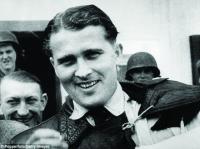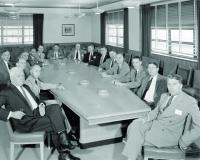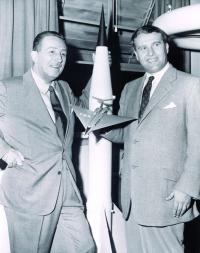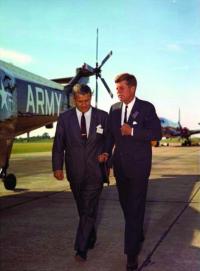Written By: Sam Ghaleb, Ridgecrest, Calif.

The German V-2 long-range missile, forerunner of the modern space launch rockets, launching at Cuxhaven, 1944.

Von Braun, after capture by Allied forces, 1945, developed the V-2 for Hitler; became American citizen involved in US space program.

Wernher von Braun, on right, at a meeting of NACA’s Special Committee on Space Technology.

Von Braun at his desk at Marshall Space Flight Center in May 1964, with models of the Saturn rocket family.

Walt Disney and Wernher von Braun, seen in 1954 holding a model of his passenger ship, collaborated on a series of three educational films.

Wernher von Braun walking with President Kennnedy at Redstone Arsenal in 1963.

Wernher von Braun and William R. Lucas, the first and third Marshall Space Flight Center directors, viewing a Spacelab model in 1974.
Seventy years ago, on September 6, 1944, the first V-2 rocket was fired against Paris. One day later the first of more than 1,100 V-2s was fired against London. Before the end of World War II, a total of 3,172 V-2 rockets were launched at Allied cities, including London, Norwich, Paris, and the Belgian cities of Antwerp, Lille, and Liege. Carrying a one-ton warhead, this liquid-fueled rocket was forty-seven feet long and could fly at supersonic speeds, and reach a height of fifty-five miles. Once launched, it was difficult to shoot down because there was no effective method for intercepting them. From January 1944 to March 1945, a total of 5789 rockets were built, making it the first mass-produced rocket in history. The V-2 rocket was not an accurate weapon. It could not be pointed against a specific military target, or a particular industrial site. The V-2 rocket could only be aimed and launched against large cities. This poor accuracy made the V-2 truly a terror weapon.
With a range of only 200 miles, the V-2 launching sites had to be built in north-east France, Belgium and Holland. These locations gave the V-2 the ability to hit cities in France and Great Britain. The attacks against English and French targets decreased only when Allied troops were able to push back Germans forces and place these cities out of range. The last V-2- related casualties in Great Britain occurred on March 27, 1945. By the end of the war, over 2,500 were killed and more than 6,500 were seriously wounded by the V-2 rocket in London alone. The port city of Antwerp in Belgium was also the target for a large number of V-2 rocket attacks from October 1944 through March 1945. These attacks caused massive destruction that left 1,736 dead and 4,500 injured in the greater Antwerp area. Thousands of buildings were damaged or destroyed as the city was struck by 590 direct hits. The largest loss of life in a single attack came in the opening phase of the Battle of the Bulge on December 16, 1944. A V-2 struck the roof of the crowded Rex Cinema in Antwerp and exploded. The destruction was total. The death toll was 567 soldiers and civilians, with 291 injured. Two hundred ninety six of the dead and 194 of the injured were U.S., British, and Canadian soldiers.
On March 17, 1945, in a desperate act, the Germans launched eleven V-2 rockets at the Ludendorff Bridge, from a point in Holland 120 miles north of the town of Remagen, where the U.S. 9th Armored Division was trying to force a crossing across the Rhine River. Due to the poor accuracy of the V-2, all of them missed the bridge and landed on the town itself killing six U.S. soldiers. The impact of the rockets, and the concussion from the explosions would eventually weaken the structure of the bridge. The bridge suddenly collapsed later into the Rhine. Eighteen U.S. Army engineers were killed while working to strengthen the bridge.
The story of the development of the V-2 rocket goes back to the early 1930s. The German military establishment began seeking out new weapons which would not violate the terms of the Treaty of Versailles. The German Army High Staff assigned this task to Captain Walter Dornberger, an artilleryman by trade. He was ordered to investigate the feasibility of military use of rockets. Contacting the German Rocket Society, he soon came in contact with a young engineer named Wernher von Braun. Impressed with his abilities, Dornberger recruited von Braun to aid in the development of liquid-fueled rockets for the military in August 1932.
Wernher von Braun, with a team of 80 engineers, was sent to Kummersdorf, to put together a small rocket in late 1934. The rocket, dubbed the A2, was somewhat successful. The next step was to move von Braun's team to a larger facility at Peenemunde on the Baltic coast. The facility would become a true rocket research center. The A2 design was later improved and a new version - A4 - was introduced. Three years later, prototypes of the rocket were launched. Many of these tests were failures, and the production of the A4, which would become the V-2, was postponed while the problems were being solved.
Early in World War II, Hitler, based on the advice of Luftwaffe Chief, Reichsmarshal Hermann Göring, was not particularly enthusiastic about the rocket program. He believed that the rocket weapon was simply a more expensive artillery shell with a longer range. As the conflict progressed, and more of the German cities and industrial centers were being pounded day and night, Hitler started to appreciate the merits of the program, and on December 22, 1942, authorized the A4 to be produced as a weapon.
In 1943 Hitler decided to use the A-4 as a "vengeance weapon," and von Braun and his team found themselves developing the A-4 to rain explosives on London. Fourteen months after Hitler ordered it into production, the first combat A-4, now called the “V-2,” was launched toward London on September 7, 1944. When the first V-2 hit London, von Braun remarked to his colleagues, "The rocket worked perfectly, except for landing on the wrong planet."
After the Allied bombing raids against Peenemunde - “Operation Crossbow” - in 1943, the Germans erroneously concluded that their production plans had been compromised. As a result, the production of the V-2 shifted to underground facilities at Nordhausen and Ebensee. The only plant to be fully operational by war's end, the Nordhausen factory, utilized slave labor from the nearby Mittelbau-Dora concentration camps. It is believed that between 10,000 - 20,000 prisoners died while working at the Nordhausen plant. More people died producing the V-2 rocket, than those killed by the V-2.
At the end of World War II in Europe, both the U.S. and Soviet Union were interested in the V-2 weapon. Both American and Soviet forces scrambled to capture existing V-2 rockets, its components, and as many scientists and engineers as possible. In the conflict's final days, von Braun and Dornberger surrendered to American troops. Much of von Braun's production team was captured by the Soviets. Under “Operation Paperclip”, the United States shipped train loads of V-2 rockets and other critical materiel to White Sands Testing Ground in New Mexico. The Soviet V-2s and the production teams were sent to Kapustin Yar, near Astrakhan. The von Braun team at White Sands developed more advanced variants of the V-2 up until 1952. The world's first successful large, liquid-fueled rocket, the V-2, broke new ground and was the basis for the rockets later used in the American and Soviet space programs.
Wernher von Braun and his team of American and German rocket scientists were eventually moved to Marshal Space Flight Center in Huntsville, Alabama. Under his leadership, the Saturn rocket was developed. Saturn, the largest rocket ever built, would be the launch vehicle for the Apollo Astronauts on their trips to the moon.
During the Cold War, the Soviet Union developed many variants of V-2 known as the Scud Missiles. Copies of the Scud were also produced by China, North Korea, Iran, and Iraq. They were used in many local conflicts in the second half of the twentieth century as terror weapons. Hundreds of these missiles still remain in service in many countries, and they will always be regarded as terror weapons in the twenty-first century.
NEXT WEEK: PELILIU
«Go back to the previous page.






